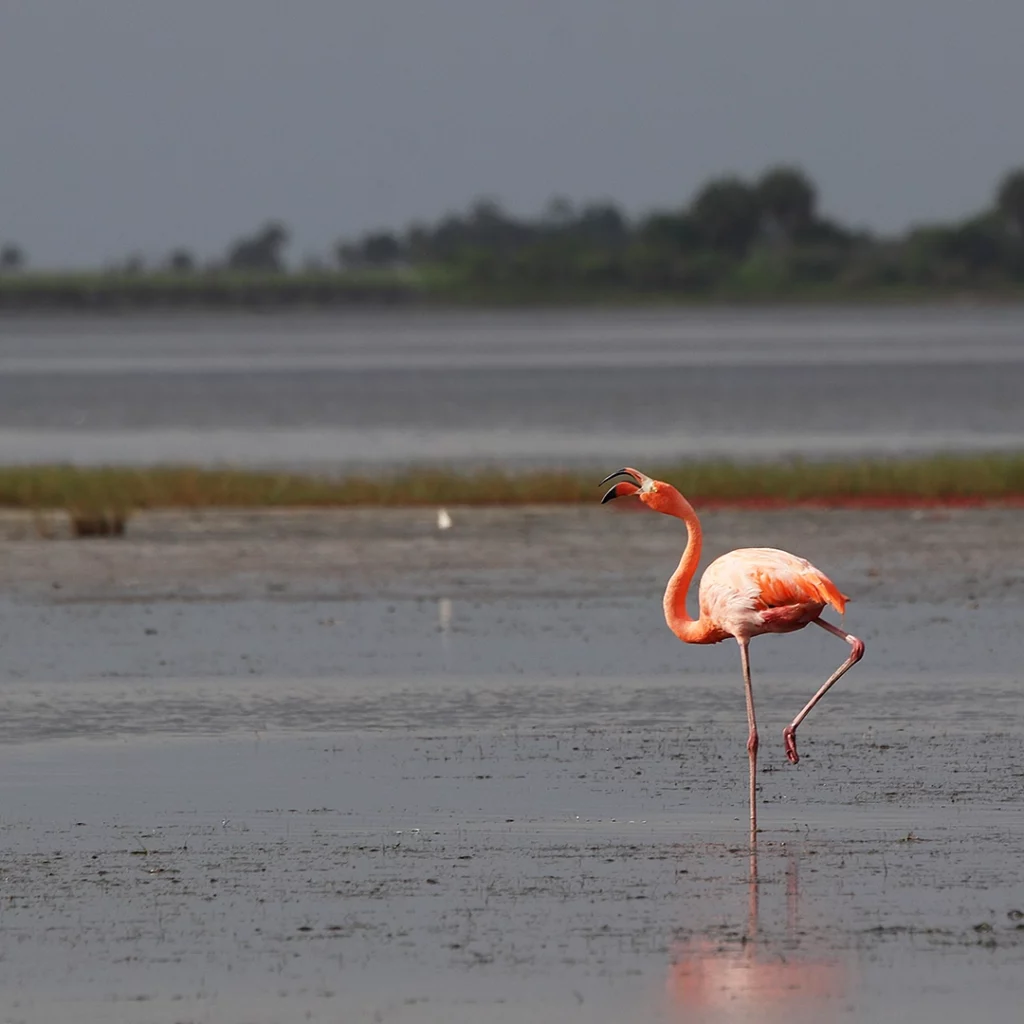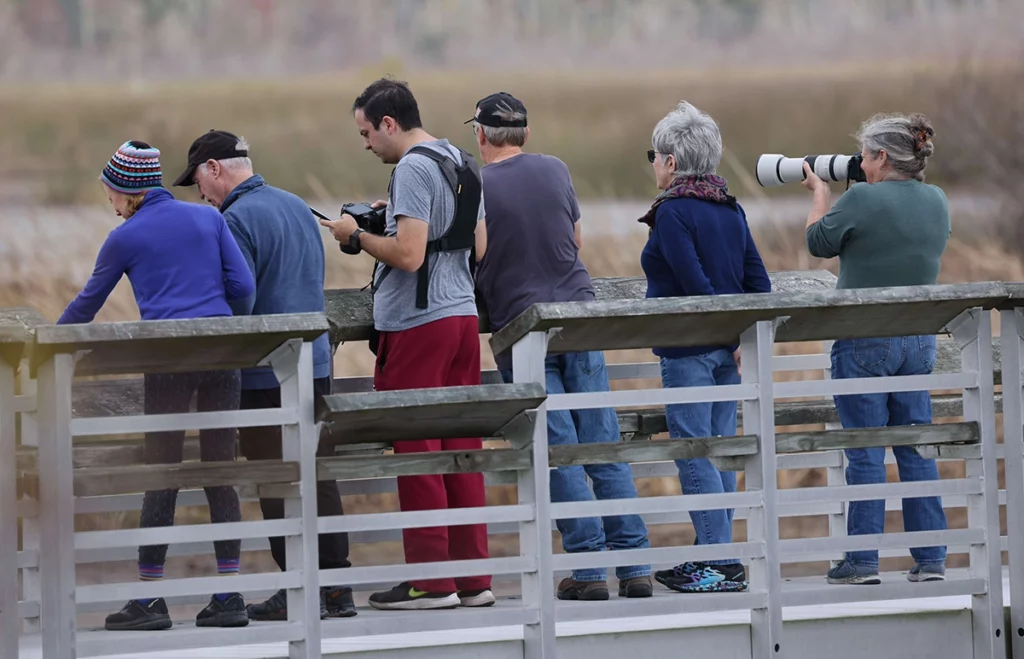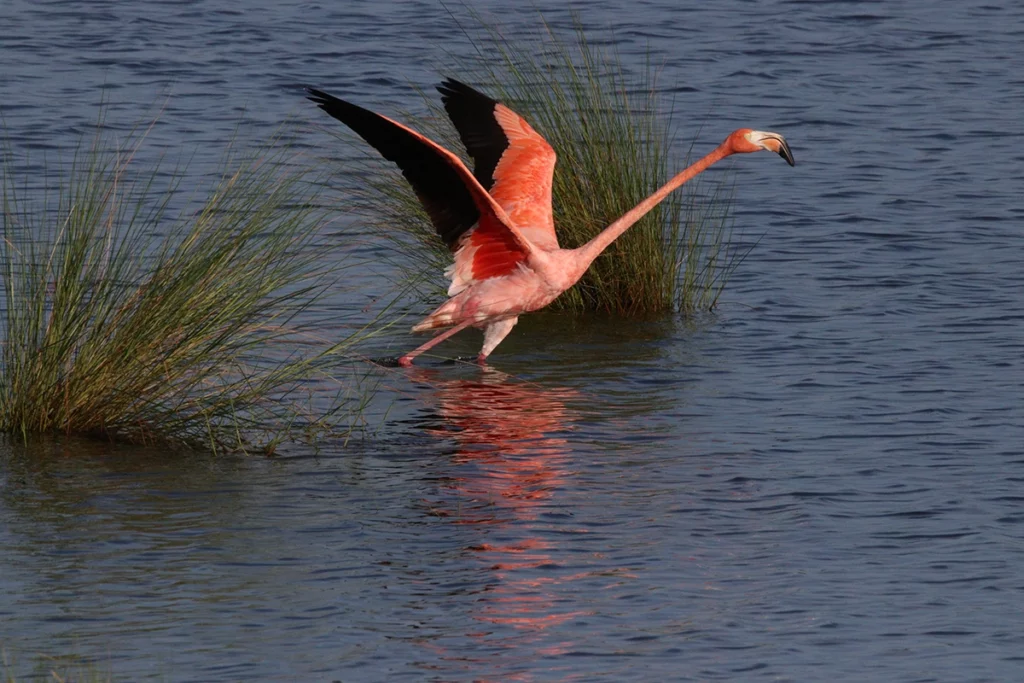Meet Pinky, Florida’s Favorite Flamingo
How the roosting of a rare flamingo in North Florida brought hope to a hurricane-rattled community, and in particular, one passionate birder.

On a brisk winter day in 2018, a small group of birders are clustered on the banks of the Stoney Bayou Trail in St. Marks National Wildlife Refuge in the Florida Panhandle. Some have driven hundreds of miles to be in this coastal preserve of salt marsh and pine flatwoods. All have focused their binoculars, birding scopes and long-range camera lenses on a pink dot at the far edge of the brackish tidal pond.
I am there among the birding brethren, shivering with excitement as I squint at the pink blur through my binoculars. A friend gestures toward her birding scope, and I bend over it, using my good eye to look through the lens. Suddenly the dot looms into view and becomes a tall, gangly, neon-bright bird. My heart thuds behind my ribs, and my breath catches in my throat as I focus on the rosy-feathered anomaly social media has already dubbed Pinky—a wild American flamingo.
St. Marks National Wildlife Refuge, situated 26 miles south of my home in Tallahassee, was established in 1931 to provide a safe wintering habitat for migratory birds. It is sacred ground to me. I have been birding there for decades and have logged some thrilling sightings. A Ross’s goose, a very rare visitor to the area, stopped by one winter. Then there was the tiny, fearless and redder-than-red vermilion flycatcher that set up shop right by the roadside several winters in a row. I once watched a peregrine falcon hunting over a brackish pond, diving and rising, diving and rising, an exquisitely beautiful killing machine. A raft of white pelicans, larger and more solemn than their brown cousins, never fails to make my heart skip a beat.
And each winter from 2009 to 2016, I joined the throngs gathered there to watch the arrival of young captive-hatched whooping cranes led to the refuge by ultralight aircraft pilots dressed as adult cranes to mimic the parental process of imprinting a migratory route as part of Operation Migration’s efforts to reintroduce the endangered cranes. The cranes were my biggest birding thrill at St. Marks—until Pinky blew in on the devastating winds of Hurricane Michael.
Born to Be Wild
Florida’s wild flamingos vanished from the state over a century ago. There were once resident populations in the Everglades, but plume hunters killed them, along with countless egrets and herons, in the late 1800s to supply adornments for ladies’ hats. At the time Pinky appeared in 2018, the only flamingos in Florida were found in zoos and aviaries, and as plastic replicas with wire legs stuck into thick St. Augustine grass lawns. Some wondered if Pinky was a captive bird, blown north by the storm. But Pinky’s spindly backward-bent legs were not banded. He was a wild bird, most likely from Cuba or Mexico’s Yucatán Peninsula.
It’s not unusual for birds to become swept up in tropical cyclones like the one that deposited Pinky at St. Marks. The Atlantic hurricane season runs from June through November each year, which coincides with fall migration, when billions of birds fly south to their wintering grounds. Fall migration is usually at its peak from August through October, which is also the busiest time in hurricane season.
It’s common for migrating birds to become entrained in a hurricane’s eye.
—Kati Schardl
These patterns have existed for millennia, and birds have evolved to adapt. They can sense when a big storm is coming. Some will pause their migration to hunker down and ride it out in place. Some will veer around the path of a storm in a temporary detour. And some birds, particularly pelagic birds such as petrels and frigatebirds, who spend most of their lives on the wing, get swept up in the bands of wind and rain and clump together for safety in the calm eye of a storm. They can become entrained there, safe from the chaos raging outside the eye, until the storm blows itself out.
Birds that congregated in the eyes of Florida’s most recent hurricanes—Helene and Milton—showed up as blue blobs on weather radar images that caused a stir on social media. Some people thought the blue blobs were A.I.-generated, others worried about the poor birds caught up in the immense weather events.
Bird migration scientists like Andrew Farnsworth at the Cornell Lab of Ornithology know that it’s common for migrating birds to become entrained in a hurricane’s eye. Most are able to resume their migration after a storm passes, and even birds blown far off their migratory path can usually find their way back to the route hardwired into their DNA.
Farnsworth says that birds have adapted to these storms and have evolved with them. They know how to deal with these things. And sometimes, some birds deal with these things like Pinky did: by settling in for a long visit in a place that looks and feels like home.

A Meet Cute
Pinky showed up just when I needed something bright and miraculous. After Michael made landfall at Mexico Beach, it barreled inland and hammered Marianna, the little town where I grew up.
Two days after the storm, I drove over to deliver a care package to a friend. The damage in the town was horrific. The little red brick house where I had lived with my family still stood, but the trees I climbed as a kid were gone, chain sawed and stacked in a towering pile of debris on the curb. Behind the house, the woods where I had played and dreamed had become a crippled grove of snapped trunks and tangled limbs.
I drove outside the town center to Florida Caverns State Park, where I had camped and hiked and explored as a Girl Scout, and where my love for nature blossomed into a lifelong passion. At the entrance to the park, downed trees and dangling power lines blocked the road. My heart broke then, and I turned the car off, leaned my head on the steering wheel and sobbed.
I cried for the park’s delicate habitats and rare plants decimated by the storm, for the birds and animals killed or forced from their homes, for the people whose livelihoods depended on the park. I cried for the little girl who knew the park’s secret places and had learned to read nature’s moods on its paths and in its woods. I cried because I felt helpless and hopeless in the face of such destruction, and I cried because new grief has a way of conjuring old griefs.
Not long after that visit to my hometown, I met Pinky at the wildlife refuge for the first time. It seemed fitting that the same devastating storm that wrecked so much of what I loved as a child had delivered the marvel of this flamingo to a place I treasured as an adult.

Hope Has Wings
Pinky hung around the refuge for five years, sometimes alone, sometimes with a group of roseate spoonbills, seemingly oblivious to the stir he caused. I loved watching him do his peculiar feeding dance, a subaquatic flamenco shuffle designed to jostle brine shrimp and other microscopic tidbits out of the alluvial muck to be siphoned through the decurved scoop of his bill.
The thrill of seeing Pinky, even from afar as a pop of color in the muted landscape of dun-colored marsh grass, never waned. My heart pumped harder, and I held my breath every time I gathered him close through the binoculars and watched his elegant neck rise from the water, droplets glinting like gems on his feathers.
I had been a regular visitor to the refuge for decades, but I began making the 30-minute drive from Tallahassee even more often after Pinky appeared. When the pandemic hit in 2020, I began driving down two or three times a week, just to get out of the house and remember what the real world looked and felt like.
I wasn’t the only one. My friend Lisa Baggett had fallen under Pinky’s spell much like I had, captivated by that initial zap of bright coral on the far edge of a tidal pool.
Baggett, 58, had a thing for flamingos long before Pinky showed up. She has been accumulating flamingos of the lawn variety for years, rotating them in her yard with adornments reflecting holidays like Halloween and Christmas. Her neighbors call her “the crazy flamingo lady.”
When the world was crazy with COVID and I couldn’t visit my mom for months, Pinky was a bright spot.
—Lisa Baggett
As the pandemic clamped down, Baggett began spending hours at the wildlife refuge watching Pinky, and she often had him all to herself. She grew to know his favorite hangouts and honed her skills as a nature photographer taking photo after photo of Pinky flying, Pinky feeding, Pinky gazing into the distance, Pinky with his pals the roseate spoonbills. Baggett was rewarded with moments so personal and intimate that she felt a special bond had developed between her and the bird.
“When the world was crazy with COVID and I couldn’t visit my mom for months, Pinky was a bright spot,” Baggett told me on a recent cold, brilliant winter day at St. Marks. She turned to Pinky and the refuge for solace when her mother entered hospice care. Grief seemed to slip away as soon as she drove through the refuge gates.
“I can come out here and be eaten alive and covered with ticks, but if I’m seeing something like Pinky that feeds my soul,
it’s worth it.”
Just as Pinky gave Baggett relief from the stressors of her life, he lifted me out of the emotional turmoil of the pandemic isolation period and the deep sadness for the devastation I saw in Marianna. Pinky was an uncomplicated, calm presence in a chaotic world.
New Arrivals
Five years after he arrived, Pinky had become a local celebrity whose appeal extended beyond hardcore birders looking to log a big find on their life lists. Parents brought their kids to see him. The refuge gift shop started selling stuffed flamingo dolls and Pinky stickers, and they posted regular updates on his whereabouts so day-trippers knew where to see him.
Then, in August 2023, Hurricane Idalia delivered six new wild flamingos—a flamboyance—to the refuge. The group included a couple of adults and several gray-toned juveniles. They were part of a post-Idalia flush of flamingo sightings in states as far north as Wisconsin.
When the Idalia flamboyance showed up, Pinky observed them for a while, then sidled up and introduced himself. People had wondered over the years whether Pinky was lonely for a mate. It seems maybe he was, or at least he was lonely for his own kind. He was photographed hanging out with an adult female flamingo and a few of the juveniles. When the new birds took off after a few days, Pinky wasn’t far behind. He had disappeared before for brief periods but had always turned up again. This time, he was gone for good.
Baggett had watched the new flamingos—“the pink lining to the hurricane’s storm clouds,” she called them—for hours. She was there when Pinky met the new birds. And she was also there when Pinky flew away with them one night. It was the last time she ever saw him. She knew he wasn’t coming back when birders familiar with the distinctive markings of his bill spotted him in Cedar Key on his way south.
She was bereft, but she didn’t give up hope that Pinky—or another flamingo—could come back to our corner of North Florida someday. Every time she went to the refuge with her camera and binoculars, she looked for a sign of him.

I missed that pink prince of the tidal ponds, too. I was surprised at how personal his departure felt. He had become a part of the wildlife refuge, just like the ibises and roseate spoonbills he congregated with, and he had become a part of my own natural cosmos—a touchstone bird in my touchstone environment. I missed feeling my heart lift on coral-colored wingbeats when he rose from the water to fly, ungainly but magnificent, before settling to feed again. I missed watching people catch sight of him for the first time, and I missed his air of lofty dignity in the midst of a pond full of honking, croaking coots and gallinules.
Hurricanes keep coming, bigger and fiercer. The big storms bring fear, devastation and heartbreak. But lately, they have also brought a pink glimmer of hope. Wild American flamingos appear to be returning to Florida. Audubon Florida counted more than 100 in the state at the beginning of the 2024 hurricane season. The birds have been seen in Florida Bay, at Merritt Island National Wildlife Refuge, around Pine Island and in other locations around the southern part of the state. Scientists hope the flamingos will settle in and establish breeding colonies.
I missed that pink prince of the tidal ponds, too.
—Kati Schardl
And in early December 2024, a lone wild flamingo appeared once again on the shores of St. Marks National Wildlife Refuge. The Pinky patrol, Baggett included, went into overdrive, tracking the bird and posting photos and daily updates. At the time of writing this, he’s still there.
Is it Pinky? This bird seems more wary of people than Pinky was, but he also has a similar distinctive marking on his bill. Maybe Pinky dropped a pin on his avian GPS map during his previous sojourn and has returned to a place that feels familiar and safe. Maybe it’s one of the flamingos that flew in after Idalia. Maybe it’s a flamingo that’s entirely new to this area.
One thing is certain: For those of us whose lives were touched by that first wild miracle the rosy color of hope, Pinky and his kin are reminders that sometimes good things blow in on the winds of the darkest storms. That is the promise of Pinky.





